Musicarta Twelve-bar Piano Styles
'Big Band Swing' - piano duet
Big Band Swing is an ideal teacher/pupil duet – the treble (primo) part uses only four melodic phrases but achieves a powerful effect with them.
Watch the demonstration video. As usual, the hands are coded green left, red right.
|
For your studying convenience, here is an audio performance (MIDI download file reference below). |
|
The primo (treble) part
The primo part of the duet uses only four melodic phrases.

Note C is always played with fingers 4 or 2 (in both hands), depending on whether the melodic figure then goes up or goes down. The G chord is always fingered as a root position triad (1-3-5).
The key fingering skill for the primo player is swapping fingers 4 and 2 on the C note.
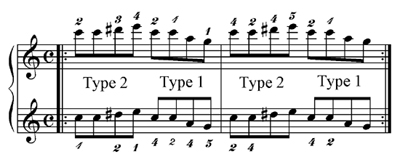
This is a good practical fingering exercise. The hands must be allowed to drift side to side. (See also the Sideways Glance section at the end of the module.)
|
The primo part can be thought of as a succession of pattern types. The MS could easily be marked up with type numbers, as an alternative to ‘the dots’. On the right you see part of the last (and most varied) chorus treated in this way. Techniques like this encourage more creative thinking. For example, once you know the piece, you will probably be able to hear in your head the lines on the right ending pattern Type 2, Type 1, Type 2. |
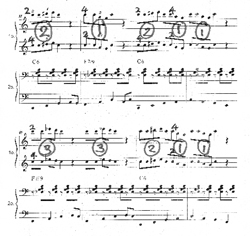 |
You can then potentially decide while playing which pattern to use – improvise, in other words!
Secondo build-up
In the key of C, The standard twelve-bar I/IV/V, tonic/subdominant/dominant chords are C, F and G. So in essence, the accompaniment pattern is this.

Both hands cover next-door root position triads. (This is the ‘basic music-making position’ explored in Musicarta’s The Pyramid Variations.)
(The 3–5 fingering is intentional. Improvising musicians are often called upon to use irregular fingering such as passing the little finger under the third finger like this.)
The right hand C chord sounds much better as a first inversion chord. With a bare minimum of ‘tweaking’, you have this attractive little study.
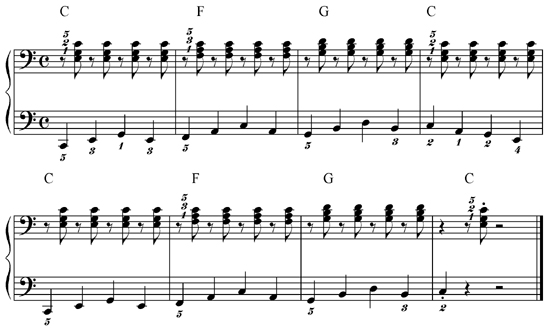
Adding the ‘kick'
The kick note in the left hand is either the third of the chord or a sixth. Here are both, drilled in all three chords. (See also the one-position drill. below.)
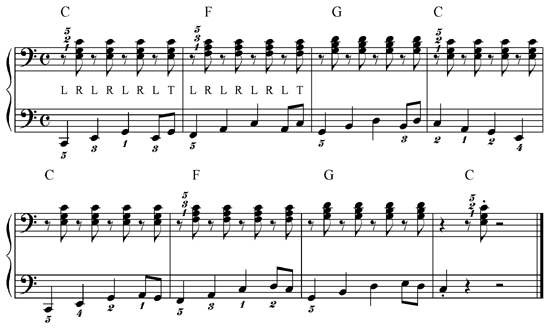
Notice the alternative fingering in the bottom line for the with-sixth pattern. In practice, the third and the sixth will be used interchangeably by the accompanist. If you know you’re going to used a with-sixth pattern, 5–4–2–1 is more elegant, except when you have a jump coming up.
Together, left, right analysis
The difficulty with the rhythm which is to be grasped is the one ‘together’ event on the last quaver in the bar. Methodical practice in one position is recommended:

The second time round, the audio plays a variation on the pattern you see here. Can you hear what it is and copy it?
Developing the right hand chords
The chords demonstrated above are quite adequate for a performance and might be all that younger secondo players can manage. They do however sound better ‘fattened up’. This section discusses the added tones used.
Here are the three ‘fattened’ right hand chords.

Some learners feel uncomfortable touching the black keys with the sides of their fingers, but it is essential for playing these chords to have the fingers well up the keys.
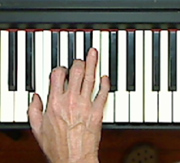 |
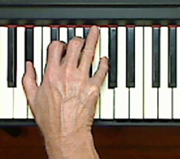 |
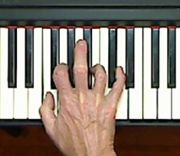 |
Added tones in chord symbols
The numbers in the chord symbols indicate the notes other than the root, third and fifth chord tones that are played. You count up scale tones from the root of the chord to identify the note to be added. The chief feature of this system to be noted is that ‘7’ in a chord symbol always denotes the flattened seventh – a note a whole tone below the root (the E flat in F7/9 and the F natural in the G7 chord.)
You will sometimes see F7/9 written F7,9 or even just F79.
Notice that the F7/9 chord uses the same notes as the tonic C6 chord, apart from the E flat. The hand keeps the same shape and just slides up the keys with the thumb climbing onto the E flat. All three chords are very much ‘right there under the fingers’ and will quickly feel natural with a little practice.
A sideways glance
There are two spin-offs from this module – the solo version of the Big Band Swing riff and Twelve-bar Diaries 11-12-14, which developed spontaneously out of the right hand drill BBS_03 in this module. Be sure to check them out!
* Regrettably, it is not possible to reliably assign the four 'hands' tracks in the download MIDI file BBS_01 to the their proper colours. You can do this yourself by opening the MidiPiano ‘Options’ dialogue and dragging all the ‘RH’ files into the Right (hand) box. They will then display correctly for demonstration purposes.
|
OUT NOW! |
THE MUSICARTA BEAT & RHYTHM WORKBOOK At last! An effective approach to keyboard rhythm & syncopation skills. Learn more! |
ONLY $24.95! |
TWELVE-BAR |
The MusicartaA methodical approach to keyboard syncopation for
|
PUBLICATIONS
exciting keyboard
creativity courses
CHORDS 101
WORKBOOK

~HANON~
video course

Musicarta
Patreon
PENTATONICS
WORKBOOK
video course

Creative Keyboard
video course

BEAT AND RHYTHM
WORKBOOK

- Volume 1 -

12-BAR PIANO
STYLES WORKBOOK

MUSICARTA MODES
WORKBOOK

PIANO STYLE

CANON PROJECT
video course

VARIATIONS
video course


- Piano Solo -
video course

- Piano Solo -


YouTube playlists





 THE LOGO
THE LOGO
